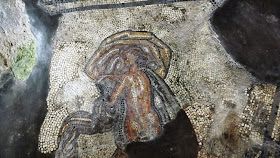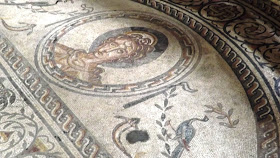The second place on our list to visit over the Easter break was a recommendation from another fan of all things Roman, my neighbour Jane. So being only a thirty minute drive from Fishbourne we set off to Bignor up on the crest of the South Downs National Park and a little further along the old Roman road of Stane Street.
The Roman Villa at Bignor was discovered by George Tupper on the 18th July 1811 when his plough struck a large stone, probably the piscina seen alongside the Ganymede mosaic, and by October 1814 after further excavation it was opened to the public. Over two hundred years later the villa is still owned by the Tupper family
The site is very rural set amid open farmland dotted with woodland and with wild deer in one of the neighbouring fields it was very easy to imagine the villa set in this scenery and a major landmark to travellers using Stane Street travelling between Londinium and the thriving port at Noviomagus.
The development of Bignor has been reinterpreted over the years with successive excavations but it now seems clear that the villa courtyard and farm building annexes were a series of developments over the three centuries following the erection of the first wooden buildings at the end of the first century.
The first stone building was the villa house on the west wing (top left in the picture above) erected in the middle of the third century AD with four rooms which were later added to with wing rooms together with a hypocaust system.
In time the north and south wings were added together with an extension to the original villa on the west wing. The south wing also incorporated a bath house. Further development followed with the walled enclosures around the main complex as seen in the top picture.
It is thought the villa gradually fell into disuse in the fourth century AD with the discovery of the blocked furnace flues connected to the bath house suggesting that leisurely bathing had stopped. The current owners don't think that, with its proximity to the south coast, raiding had caused its desertion as, too date, there has been no evidence of fire or destruction from the excavations, but with plenty of the site left to future generations of archaeologists, Bignor may still have other secrets to reveal.
Today the site reveals some of the finest, mainly fourth century, mosaics in the country and following our visit to the earlier site at Fishbourne made a fascinating comparison. All the exposed floors are still protected from the elements by the Georgian style Grade II listed agricultural buildings erected first in 1812, seen in the header photo. They were built on the original Roman wall foundations, something that would not be allowed today, but that gives a really good sense of the size of the original Roman structures.
The layout of the buildings is shown in the plan above and so I have grouped the pictures based on the named areas of the plan for convenience. As you will see from studying the plan we are principally only looking at a small section of rooms located on the north west corner of the villa complex excluding the later work that uncovered the bath house and frigidarium on the south east corner
GANYMEDE & PISCINA
The first room on entry to the complex is the Ganymede room, a large dining room that was not heated and probably reserved for use in the summer.
The centre of the room is dominated by a water basin or piscina, that probably contained a small fountain. The feature is surrounded by a mosaic depicting six dancing girls or maenads - followers of Dionysus the Olympian God of wine and pleasure, better known to the Romans as Bacchus - with flying veils, seen above and below.
These were the first mosaics discovered in 1811.
https://en.wikipedia.org/wiki/Dionysus
Above the piscina is the magnificent mosaic depicting a youthful Ganymede being carried from Mount Ida by an eagle, to become a cup bearer to the Gods and depicted wearing a red Phrygian cap.
https://en.wikipedia.org/wiki/Ganymede_(mythology)
Wow what a start!
GEOMETRIC MOSAIC
The next room had underfloor heating and contained this amazing geometric mosaic, sadly pictured under a protective wire cage, but hopefully still displaying the vivid colours and intricate design outlined in the display panel picture below.
VENUS & THE GLADIATORS
The next entrance leads the visitor into what was probably the winter dining room kitted out with the full hypocaust under floor and wall flues heating system, a must have status symbol for any villa owner worth his salt in the third and fourth century, and given the climate a necessity to comfortable living.
The room has a semicircular end on the north side and the eye is immediately drawn to the magnificent mosaic panel containing the head of a Goddess, believed to be Venus.
Below Venus is a panel depicting winged cupids dressed as gladiators. The net and trident carrying retarius versus the secutor with visored helmet, greaves, shield and sword can be seen together with the rudarius or umpire carrying his stick of office overseeing proceedings.
This is probably one of the finest mosaics in Britain and we were all so pleased to have seen it. Absolutely stunning!
WINTER
The next room on the plan was accessed via a short walk across the grass to the next building which houses the floors from the earliest construction on the west wing.
The doorway into the building is constructed around the original Roman access and the visitor is greeted by "Winter" the only depiction remaining from what was a large square shaped mosaic depicting all of the four seasons.
DOLPHIN
Further along from the depiction of winter is this lovely dolphin, which also has the initials of perhaps the designer. Sadly I missed that important feature in my picture as I was just enjoying the overall design with the curve in the back of the animal really capturing the swimming motion. It reminded me of seeing these creatures in the wild in the clear blue waters of the Indian Ocean a few years ago.
FOUR SEASONS
This floor is part of the original winged corridor of the West Wing Villa building and thus contains the oldest mosaic on display at Bignor.
The walls up to a meter in height in the picture are original and were found with the remains of the painted plaster in five vertical panels of red and white.
The mosaic is covering the four seasons theme and a similar representation of winter seen in the previous larger design can be seen bottom right of the design in the picture below, with the head of Medusa in the centre.
NORTH CORRIDOR
The geometric mosaic in the north corridor is considered to be the longest mosaic in Britain at twenty four metres long and originally ran the whole length of the north wing.
The south wall of this corridor (left of the picture above) is thought to have been only about shoulder high with pillars like the one in the photo supporting a lean-to roof.
MUSEUM
As our route around the north west corner buildings came full circle we took time to grab a cup of tea and look at the items discovered over the years housed in the museum together with models illustrating the different look of the villa as it was developed.
 |
| The skeleton of a baby |
 |
| Roman tiles, don't you just love them |
BATHS & MEDUSA MOSAIC
The baths were first excavated between 1813 and 1815, with the covering building over the Medusa mosaic in 1818. The frigidarium or cold bath were originally excavated in 1925 with further work in 1958 and 1985.
The medusa room served as a heated changing room or apodyterium and linked to the frigidarium, a tepidarium or warm room and a caldarium or hot room and on to the hot baths. The baths served for the whole of the villa complex and it seems were altered and extended on several occasions. The layout of these various rooms can be seen in the model below.
This little chap, below, was probably looking for his towel on his way back to the changing room.
Bignor was a real treat after the delights of Fishbourne and like the former very different high status Roman building comes highly recommended as a place to visit when in the area.


































Whilst on my Great South Coast tour a while back taking in various Saxon shore forts /Henry VIII castles and Martello towers , I saw the sign post for Bignor and so popped in on route. It is an excellent stop off and with Fishbourne so near I don't think it gets the credit it deserves. Unfortunately it is not part of the National trust but is a little cheaper to visit. It is also not a big site ( big enough to warrant a Tea Room ) but is very well presented .I would suggest combining a visit here with some thing else nearby if making a special trip out.
ReplyDeleteHi Steve, the Great South Coast Tour eh, is that similar to the Grand Tour where you not only take in the culture and finer ways of living, but sharpen up your foreign language skills as well. You must be fluent in West Sussex and Olde Kentish.
ReplyDeleteYour right, Bignor is not a large site, but more than makes up for that in what is on show together with a very friendly welcome and eagerness to share knowledge about the history and with plenty of other sites in the area makes it simple to combine visits to it and other attractions